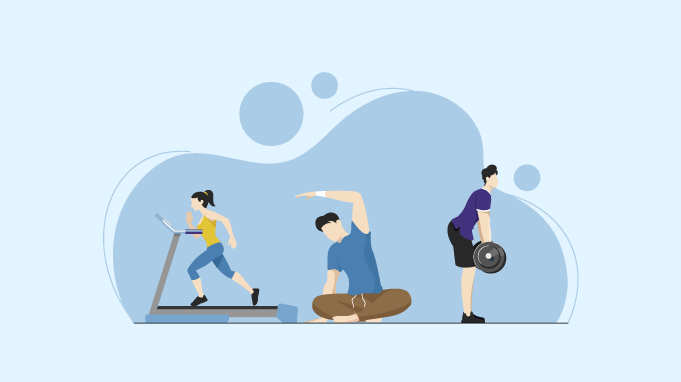Staying fit and healthy can be a challenge, especially when you spend most of your day sitting at a desk in the office. However, taking a break to engage in physical activities throughout the day not only boosts your fitness levels but also improves your overall productivity and well-being. In this blog, we’ll explore some fun office fitness challenges that you can incorporate into your daily routine to keep yourself active and energized.
Contents
50 Ideas For Office Fitness Challenge

These are the most used 50 ideas for office fitness challenges:
- Walking meetings: Schedule meetings to be walking meetings instead of sitting at a conference table.
- Stand-up desks: Use standing desks for an hour each day.
- Lunchtime walks: Take a 20-30 minute walk during your lunch break.
- Planking challenge: Hold a plank position for 30 seconds, gradually increasing the duration over time.
- Stair challenge: Take the stairs instead of the elevator.
- Squat challenge: Do a set of 10-15 squats every hour.
- Push-up challenge: Do a set of 5-10 push-ups every hour.
- Stretching challenge: Take a 5-10 minute break every hour to stretch.
- Water drinking challenge: Drink a certain amount of water each day.
- Desk cycle challenge: Use a desk cycle for 30 minutes each day.
- Wall sit challenge: Hold a wall sit position for 30 seconds, gradually increasing the duration over time.
- Jumping jack challenge: Do a set of 10-15 jumping jacks every hour.
- Burpee challenge: Do a set of 5-10 burpees every hour.
- Plank rotation challenge: Rotate from side plank to regular plank, holding each position for 30 seconds.
- Chair dips challenge: Do a set of 10-15 chair dips every hour.
- Lunges challenge: Do a set of 10-15 lunges every hour.
- Resistance band challenge: Use resistance bands for 10-15 minutes each day.
- Yoga challenge: Take a 10-15 minute break every hour to do some yoga poses.
- Dance party challenge: Take a 5-10 minute dance break every hour.
- Hula hoop challenge: Use a hula hoop for 5-10 minutes each day.
- Medicine ball challenge: Use a medicine ball for 10-15 minutes each day.
- Mini-trampoline challenge: Use a mini-trampoline for 5-10 minutes each day.
- Foam roller challenge: Use a foam roller for 10-15 minutes each day.
- Resistance band row challenge: Do a set of 10-15 resistance band rows every hour.
- Chair yoga challenge: Do a set of chair yoga poses every hour.
- Calf raise challenge: Do a set of 10-15 calf raises every hour.
- Wall push-up challenge: Do a set of 10-15 wall push-ups every hour.
- Wrist exercise challenge: Do a set of wrist exercises every hour.
- Neck exercise challenge: Do a set of neck exercises every hour.
- Ab wheel challenge: Use an ab wheel for 10-15 minutes each day.
- TRX suspension trainer challenge: Use a TRX suspension trainer for 10-15 minutes each day.
- Kettlebell challenge: Use a kettlebell for 10-15 minutes each day.
- Pull-up challenge: Do a set of 1-3 pull-ups every hour.
- Dip bar challenge: Use a dip bar for 10-15 minutes each day.
- Burpee box jump challenge: Do a set of 5-10 burpee box jumps every hour.
- Agility ladder challenge: Use an agility ladder for 10-15 minutes each day.
- Battle ropes challenge: Use battle ropes for 10-15 minutes each day.
- Treadmill challenge: Use a treadmill for 10-15 minutes each day.
- Exercise ball challenge: Use an exercise ball for 10-15 minutes each day.
- Kickboxing challenge: Take a 10-15 minute break every hour to do some kickboxing.
- Hiking challenge: Plan a weekend hiking trip with coworkers.
- Bike-to-work challenge: Bike to work instead of driving or taking public transportation.
- Outdoor yoga challenge: Take a 30-minute break to do yoga in a nearby park.
- Kayaking challenge: Plan a kayaking trip with coworkers.
- Office sports challenge: Set up an office sports league for fun competitions during lunch breaks or after work.
- Lunchtime gym challenge: Hit the gym during your lunch break for a quick workout.Outdoor running challenge:
- Go for a run outside during your lunch break or after work.
- Trampoline park challenge: Visit a trampoline park for a fun and active team-building activity.
- Obstacle course challenge: Set up an office obstacle course and challenge coworkers to complete it.
- Dance fitness challenge: Take a dance fitness class with coworkers after work.
How Does It Help Employees?
Implementing office fitness challenges can have numerous benefits for employees, both physically and mentally. Here are some ways office fitness challenges can help employees:
- Improved physical health: Regular physical activity can help employees maintain a healthy weight, reduce the risk of chronic diseases, such as diabetes and heart disease, and improve overall fitness levels.
- Increased energy and productivity: Exercise releases endorphins, which can boost mood and increase energy levels, leading to improved productivity and focus throughout the workday.
- Reduced stress and anxiety: Exercise can help reduce stress and anxiety levels, leading to better mental health and overall well-being.
- Improved teamwork and morale: Participating in office fitness challenges can build camaraderie among coworkers, improve teamwork skills, and create a more positive and supportive work environment.
- Better work-life balance: Taking breaks for physical activity can help employees maintain a better work-life balance, leading to improved job satisfaction and overall happiness.
- Reduced absenteeism: By promoting healthy behaviors and reducing the risk of illness and chronic diseases, office fitness challenges can help reduce absenteeism and improve employee retention.
How Does it Help The Managers?

Implementing office fitness challenges can benefit managers in several ways, including:
- Improved employee morale: Encouraging physical activity and promoting a healthy work environment can boost employee morale, leading to a more positive and motivated workforce.
- Increased productivity: Regular physical activity can lead to improved focus and productivity, which can benefit managers in terms of meeting deadlines and achieving business goals.
- Enhanced teamwork: Office fitness challenges can improve teamwork skills and foster a more collaborative work environment, leading to better communication and problem-solving among team members.
- Reduced healthcare costs: By promoting healthy behaviors and reducing the risk of illness and chronic diseases, office fitness challenges can help reduce healthcare costs for the company.
- Improved employee retention: By promoting a healthy work environment and supporting employee well-being, office fitness challenges can help improve employee retention and reduce turnover rates.
- Increased job satisfaction: Providing opportunities for physical activity and promoting work-life balance can help improve job satisfaction among employees, leading to a more motivated and engaged workforce.
Which Method Should Managers Choose?

There is no one-size-fits-all method for implementing office fitness challenges, as the approach that works best will depend on factors such as company culture, employee preferences, and available resources. Here are some methods that managers could consider:
- Group challenges: Encourage employees to participate in group challenges, such as a walking challenge, a yoga challenge, or a sports league, to build camaraderie and promote teamwork.
- Individual challenges: Offer individual challenges, such as a plank challenge or a stair challenge, to promote healthy competition and personal accountability.
- Wellness programs: Implement a comprehensive wellness program that includes fitness challenges, health screenings, and educational resources to support employee well-being.
- Incentives: Offer incentives, such as gift cards or extra vacation days. This is for employees who participate in fitness challenges or achieve certain health goals.
- Flexibility: Provide flexibility in work schedules to allow employees to participate in physical activity during the workday. These are such as taking a lunchtime walk or attending a fitness class.
Ultimately, the method chosen should align with the company’s culture and values, and be tailored to the needs and preferences of employees. It is also important for managers to communicate the benefits of office fitness challenges and actively encourage participation to ensure success.
Conclusion
In conclusion, office fitness challenges can provide numerous benefits to both employees and managers. By promoting physical activity and a healthy work environment, companies can improve employee morale, productivity, and overall well-being, while also reducing healthcare costs and improving employee retention. However, the approach taken should be tailored to the unique needs and preferences of employees, with a focus on creating a fun and engaging experience that promotes teamwork and personal accountability. By embracing a culture of fitness and wellness, companies can foster a more positive and supportive work environment. This leads to increased job satisfaction and success.
Employee wellness programs are the key to improving employee motivation, productivity, and retention. At MantraCare, we have a team of health experts, counselors, and coaches who serve corporate employees with 10+ well-being programs including EAP, Employee Diabetes Reversal, Corporate MSK, Employee Fitness, Corporate Yoga, and Employee Meditation.
